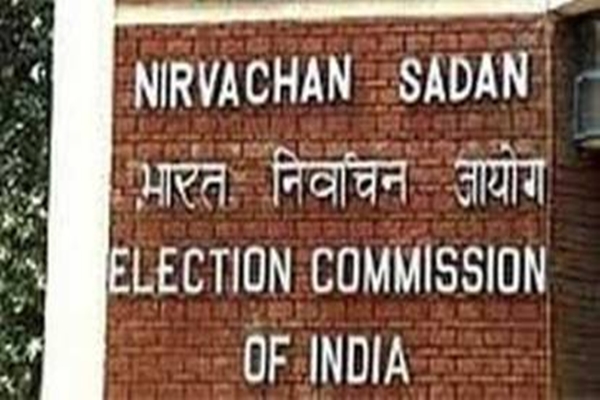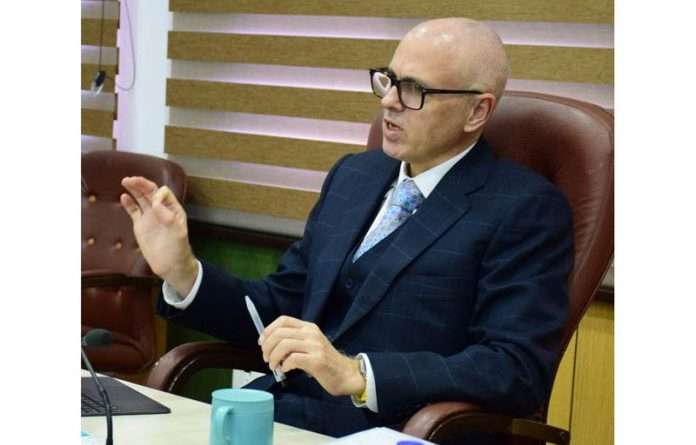After Four Years, J&K to Elect Its Rajya Sabha Members Again
By : Javid Amin | October 6, 2025 | Srinagar
After more than four years of delay, Jammu and Kashmir will finally send representatives to the Rajya Sabha, India’s Upper House of Parliament. The Election Commission of India (ECI) has announced that voting for four Rajya Sabha seats from the Union Territory will take place on October 24, 2025 — marking the first such election since the abrogation of Article 370 and the reconstitution of J&K as a Union Territory in 2019.
These four seats have remained vacant since February 2021, when the terms of former MPs Ghulam Nabi Azad, Nazir Ahmad Laway, Mir Mohammad Fayaz, and Shamsher Manhas expired. The absence of an elected Assembly had prevented elections until now.
With the J&K Legislative Assembly restored last year, this long-awaited Rajya Sabha election is set to become a symbolic and strategic contest — not just for parliamentary representation, but for political legitimacy and coalition endurance in a rapidly evolving regional landscape.
Official Notification: Election Timeline Announced
The Jammu and Kashmir Legislative Assembly Secretariat issued three separate notifications on Thursday, officially commencing the process for the biennial elections.
According to the notification by the Union Ministry of Law and Justice,
“In pursuance of Section 10 of the Representation of the People Act, 1951, the President is pleased to call upon the elected members of the Legislative Assembly of the Union Territory of Jammu and Kashmir to elect four members of the Rajya Sabha to fill the seats that fell vacant in February 2021.”
The timeline for the election process is as follows:
| Event | Date & Details |
|---|---|
| Last date for filing nominations | October 13, 2025 (Monday) |
| Scrutiny of nominations | October 14, 2025 (Tuesday, 11 AM) |
| Last date for withdrawal of candidature | October 16, 2025 (Thursday, 3 PM) |
| Polling date | October 24, 2025 (Thursday, 9 AM – 4 PM) |
Candidates must file their nominations before the Secretary or Additional Secretary of the Legislative Assembly in Srinagar between 11 AM and 3 PM on working days.
Why These Seats Matter
The four Rajya Sabha seats from J&K have remained vacant for over four years—a gap unprecedented in the region’s parliamentary history.
-
These seats will restore J&K’s representation in the Upper House, where the region has had no voice since 2021.
-
Politically, they will test the strength of the newly constituted J&K Assembly, alliances, and regional power equations.
-
Symbolically, this election signifies a partial return to democratic normalcy, following years of central rule and political uncertainty.
The Players and the Political Chessboard
1. The NC–Congress Alliance: The Incumbent Bloc
The ruling coalition of the National Conference (NC) and the Indian National Congress (INC) is seen as the frontrunner in this race.
Strengths:
-
The alliance currently commands a majority in the Legislative Assembly.
-
Coordination between Omar Abdullah (NC) and Vikar Rasool Wani (INC) has reportedly improved after initial friction.
-
Both parties view the RS elections as an opportunity to demonstrate governance stability and coalition durability.
Challenges:
-
Seat-sharing disagreements could still emerge. NC, being the larger partner, wants at least two to three of the four seats, while Congress insists on one.
-
Local power dynamics — especially in Pir Panjal and Jammu regions — could complicate consensus.
Party insiders say the alliance is likely to secure three of the four seats comfortably, leaving the fourth seat to be contested by the BJP.
2. BJP: Fighting for Symbolism and Foothold
Even without Assembly majority, the BJP is contesting all four seats.
Why it matters to BJP:
-
Winning even one RS seat from J&K would symbolically reaffirm the party’s post-370 vision of “integration and normalcy.”
-
It allows BJP to retain a political narrative in J&K even while being in opposition.
-
The party will rely on independent MLAs and support from smaller outfits like the J&K Apni Party and Democratic Azad Party (DAP).
BJP insiders suggest that the party’s focus will be on the Jammu belt, where it continues to have ideological and electoral strength.
3. PDP: Symbolic Contest, Political Message
The People’s Democratic Party (PDP), led by Mehbooba Mufti, is numerically weak but politically vocal.
Likely Strategy:
-
Field at least one candidate to assert ideological independence from both NC and BJP.
-
Use the election platform to highlight issues of democracy, statehood, and civil rights.
-
Reconnect with grassroots workers in South Kashmir who have drifted since 2018.
While PDP is unlikely to win a seat, the contest itself serves to project the party’s continued resistance to central domination and its identity as a “voice of conscience.”
4. The Swing Factors: Apni Party & Democratic Azad Party
Two relatively newer outfits—J&K Apni Party (led by Altaf Bukhari) and Democratic Azad Party (DAP) (led by Ghulam Nabi Azad)—hold limited Assembly representation but potentially crucial swing votes.
-
Apni Party: Known for its pragmatic and pro-development stance, often perceived as being close to the Centre.
-
DAP: Although diminished since its launch, Ghulam Nabi Azad retains personal loyalty among select legislators.
Both are expected to play kingmaker roles, particularly if the BJP manages to consolidate independents and defectors.
Historical Backdrop: Why These Seats Were Vacant
The four seats became vacant upon the retirement of:
-
Ghulam Nabi Azad and Nazir Ahmad Laway (February 15, 2021)
-
Mir Mohammad Fayaz and Shamsher Manhas (February 10, 2021)
Since J&K had no elected Assembly at that time—the erstwhile state was under Lieutenant Governor’s administration—the elections were deferred indefinitely.
Both NC and PDP had repeatedly criticised the delay, accusing the Centre and the ECI of denying J&K its parliamentary representation even after the Assembly was restored in 2024.
This election, therefore, carries deep constitutional and emotional resonance, being the first Upper House election post-restoration of the Assembly.
Inside the Alliance Math: Possible Outcomes
| Bloc / Party | Expected Seat Share (Projection) | Key Factors |
|---|---|---|
| NC–Congress Alliance | 3 Seats | Coalition majority; joint strategy |
| BJP & Allies (Apni Party + DAP + Independents) | 1 Seat | Strategic vote transfer; Central influence |
| PDP | 0 Seats (Symbolic) | Ideological assertion; opposition relevance |
This projection assumes the NC–Congress bloc holds its numbers firm and manages smooth coordination of votes. However, if independents shift or one bloc underperforms, a 3–1 split could turn 2–2—a scenario that would dramatically alter narratives.
Expert Analysis: Why the RS Polls Are a Mini-Referendum
Political analysts in Srinagar and Delhi describe these elections as a barometer of post-370 politics:
-
If NC–INC dominates: It would reaffirm public and political confidence in coalition governance and regional autonomy discourse.
-
If BJP clinches a seat or two: It would strengthen the narrative that the Centre’s policies are gaining ground and that “integration” has translated into “acceptance.”
-
If smaller parties swing results: It will prove that fragmentation in Valley politics continues, weakening any unified regional front.
Assembly By-polls: Parallel Ground Reality Check
Simultaneously, the Election Commission is expected to announce Assembly by-polls for several vacant constituencies across J&K, including Anantnag, Baramulla, Rajouri, and Poonch.
These contests will act as a grassroots barometer of public sentiment and local power balance:
-
NC & INC: Aim to defend existing seats and expand in border districts.
-
BJP: Will try to showcase its development narrative and stronghold in Jammu.
-
PDP: Seeks a comeback in South Kashmir.
-
Apni Party & PC: Fighting to prove their independent existence.
Together, the RS and by-polls will offer a complete picture of J&K’s political trajectory—from the Assembly floor to the voter’s doorstep.
The Road to October 24: What to Watch
-
Candidate Finalisation: NC and Congress are expected to announce joint candidates by the first week of October.
-
Cross-Voting Possibilities: A handful of independents could become decisive, particularly if alliances falter.
-
Central Oversight: The Centre and ECI will closely monitor proceedings to ensure transparency amid political sensitivities.
-
Symbolism of Participation: For many Kashmiris, this election is a test of whether political normalcy has genuinely returned or remains a procedural illusion.
Bottom-Line: A Battle for Representation and Relevance
As Jammu and Kashmir prepares to elect its four Rajya Sabha members on October 24, the contest is as much about numbers as it is about narratives.
-
For the NC–Congress alliance, victory will reinforce its legitimacy as the ruling coalition and the voice of democratic restoration.
-
For the BJP, even one seat will symbolize a strategic win and the party’s persistence in J&K politics.
-
For the PDP and smaller outfits, it’s an existential test—proof that their voices still matter in a reshaped political ecosystem.
After years of political vacuum, the Upper House elections mark a symbolic return to institutional democracy in Jammu and Kashmir — but they also raise the question: Who truly represents J&K’s aspirations in the new political order?



